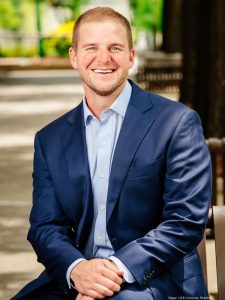Three weeks after I joined Southern Research as president and CEO, a 12-story condo building collapsed in Miami, killing 98 people and raising alarms about the structural integrity of buildings across the country. This tragedy led many organizations to take a hard look at the safety of their physical structures. Southern Research was no exception, and our review quickly turned to the Quinlan Castle, an old apartment building sitting in the heart of our campus.
This tragedy led many organizations to take a hard look at the safety of their physical structures. Southern Research was no exception, and our review quickly turned to the Quinlan Castle, an old apartment building sitting in the heart of our campus.
With its stone exterior, the castle appears solid from the outside. But inside, the castle is in literal shambles, falling victim to the elements and vandals and time. To assess its safety, we hired a structural engineer and other building experts this summer to evaluate the castle and its potential for rehabilitation.
They found serious safety hazards. Beyond the obvious — fallen interior walls, caved-in ceilings, and buckled floors — they noted serious structural issues. They included corroded concrete with exposed, rusted rebar — one of the very issues cited in the Miami condo collapse.
Could we bring back the castle to use for our scientific endeavors? Our building experts concluded that addressing the safety issues alone would be cost-prohibitive, and the building simply could not be converted, at any price, into the modern lab space our scientists need.
Even with current building codes, the load requirements for an apartment building are less than half the load requirements for a research facility like ours. The assumption is that the building codes were even less stringent in 1927. The ceiling heights from that time can’t accommodate modern infrastructure and life safety needs, and trying to ensure disability access would be nearly impossible in a structure whose insides are defined by steep, narrow stairs.
After careful study and consideration of our options, we sought and received approval from the city of Birmingham’s Design Review Committee to bring down the castle. We will replace it with a modern structure that teems with some of our state’s best science, retains and attracts talent to make Southside more vibrant, and becomes a source of pride for our community.
As one of Birmingham’s oldest employers, we respect historical institutions. We don’t take joy in bringing down a building that has stood for so many years. We welcome suggestions from the community about ways that we may be able to preserve and use some elements of the castle for other purposes.
But this almost century-old structure simply does not work for Southern Research’s mission, nor for the dedicated employees who work here.
Benefit Birmingham, Jefferson County and the state of Alabama
COVID-19 revealed healthcare heroes in our midst, and I am proud to work alongside many of them at Southern Research. Our scientists have been studying viruses like COVID-19 for 20 years. When this new global threat emerged, the team at Southern Research shifted into high gear, working nonstop to test possible treatments and employing every possible tool to combat the pandemic.
Scientists at Southern Research have made substantial contributions in testing, treatments and vaccines for COVID-19. In partnership with UAB, we helped refine remdisivir, the first treatment approved for the virus. In partnership with Tonix Pharmaceuticals, we helped develop a potential vaccine that is in clinical trials. These are just two examples, and they don’t begin to capture what Southern Research has contributed to our nation’s pandemic response.
Heading into 2022, we have an opportunity to invest more and expand this important part of our mission, both to magnify our work to combat COVID and to better prepare for the next threat that might endanger our family, our friends, and the Birmingham community.
Our plans for a new facility on our Southside campus – a center for pandemic resilience — will double the amount of lab space we have available for research and development on infectious diseases like COVID-19. It will also broaden our capacity to address common diseases and health conditions that have made COVID particularly lethal to Alabamians.
In addition to extending our scientific reach, the new space will allow us to hire 100 additional scientists and nurture commercial research, enlarging our economic impact as well.
I believe everyone agrees our plans will benefit Birmingham, Jefferson County and the state of Alabama. But there is understandably some discomfort that this important new facility will be located at the site of Quinlan Castle.
The castle is a charming, quirky, almost whimsical landmark in Birmingham. Built in 1927 as an apartment building, its appearance was designed to replicate castles that American soldiers had seen in Europe during World War I.
Like many others in Birmingham, I’ve smiled in passing the castle and seeing those turrets and battlements in the city skyline.
But we can no longer ignore the castle’s dangerous condition issues, the result of many decades of deterioration and neglect.
We firmly believe that trying to preserve the castle is not the best use of this site or our resources. We believe our community will be much better served by building a facility that allows us to meet the challenges of today and tomorrow — and that represents a real investment in Birmingham’s future.
We are building a castle for the 21st century. This new structure won’t feature turrets or battlements, but it will allow us to improve our fight against some our community’s most dangerous enemies – chronic illness and infectious disease.
Josh Carpenter, Ph.D., is president and CEO of Southern Research (SR), an independent, nonprofit scientific research organization. Now affiliated with UAB, SR was founded in 1941 and currently employs 400 full-time scientists, engineers, and professional personnel.
This column appeared on ComebackTown.com.